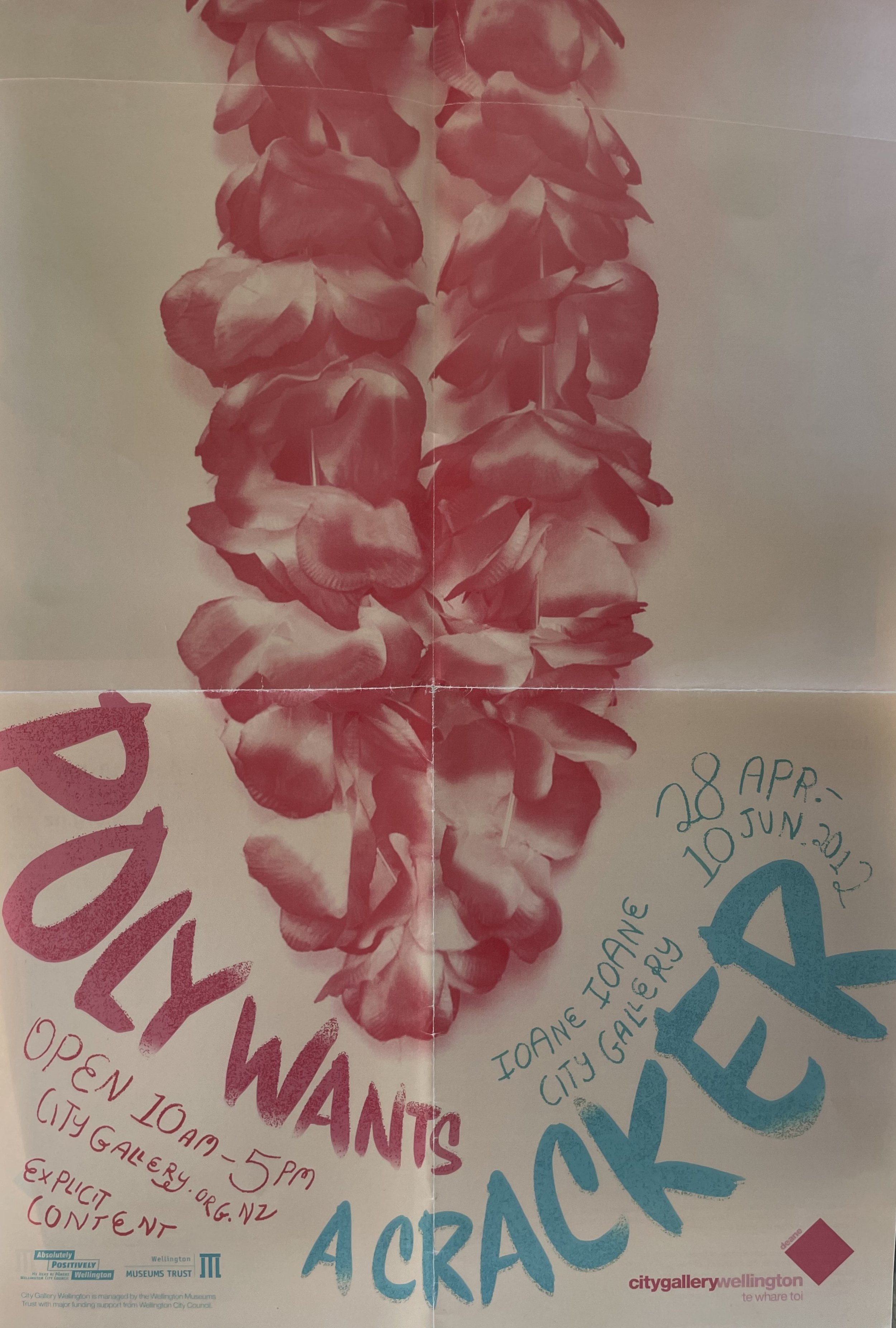Ioane Ioane: Poly Wants a Cracker
City Gallery Wellington | Te Whare Toi
28 April–10 June 2012
The following essay is taken from the catalogue publication that was written to accompany the exhibition:
loane loane: Poly Wants a Cracker
By Reuben Friend
Poly Wants a Cracker (2002) is a provocative installation by Auckland-based artist loane (John) loane. It was first exhibited at the Sydney College of Arts Gallery in 2002. On its return to Aotearoa New Zealand the installation was acquired by the Museum of New Zealand Te Papa Tongarewa for their permanent collection. Ostensibly a work that pokes fun at the idea of the Pacific as an erotic paradise for white males, behind the sexual bravado of this installation is a multi-faceted exploration of Polynesian and Palagi attitudes towards body image and sexual propriety.
Poly Wants a Cracker consists of nineteen peach-coloured dildos sourced from a sex store on Auckland's Karangahape Road. Hung along the gallery walls at eye height, each appendage is symbolically laid with a synthetic flower lei — a delicate and welcoming feminine element among a disconcertingly confident exposition of masculinity. Standing at the rear of the installation is a handsome male mannequin. Looking like a young Elvis Presley in Blue Hawaii (1961) he greets visitors with a steel ukulele in his hands, a flower lei around his neck, a grass skirt wrapped round his waist and a happy smile. Replete with a spray-on silver tan, he stands like a trophy, rhythmically swaying his synthetic grass skirt (via an internal electric motor).
loane places these sexualised objects on display as both challenge and memorial. On one hand he presents the male body as an arousing commodity to be objectified, packaged and sold. Yet on the other, the dismembered appendages create a sense of unease, as if they have been lopped off and mounted like big game trophies. This space between cultural commodity and cultural taboo is where Poly Wants a Cracker really operates.
While the installation has a Polynesian theme, all the dildos are noticeably Caucasian in colouring and the ukulele-playing mannequin also appears to be Palagi. By placing the white male into this Polynesian aesthetic, loane turns the tables on stereotypes of the Pacific as an erotic paradise, thereby suggesting that such perceptions are possibly a manifestation of Western desires
For loane however, the solemn state of these prosthetic penises recalls the thousands of mea sa, sacred male organs that were cut off carved figures throughout Polynesia by early European missionaries. Seeking to civilise the Pacific through Christianity, missionaries taught Polynesian people to perceive the human body as a source of sin, something that should be covered to prevent temptation. From these teachings came the tiputa, the Polynesian poncho, and the touristic grass skirt - garments that offer little function in a tropical climate.
Today many Pacific people continue to practise very conservative values based on the imposed nineteenth-century perceptions of modesty and sexual prudence. The irony of the situation is that Pacific people are now often more conservative than the European nations that imparted these values on them.
Poly Wants a Cracker explores these shifts in cultural values and belief systems. Pacific communities in New Zealand and abroad are undergoing massive social changes. Pressure to attain Western forms of wealth and material culture has lead to what loane describes as fiapalagi attitudes: a desire to behave like Palagi to the detriment of one's own culture. The title of the work alludes to this phenomenon. Combining the term 'Poly', meaning Polynesian, with 'Cracker', a racial slur for white males, loane dares to suggest that Pacific men and women are attracted to Palagi and fiapalagi practices as a means of advancing themselves economically and socially.
In 2003 loane extended the issues raised in Poly Wants a Cracker in a work titled Tangaroa. Known by many names, including Tagaloa-lagi in Samoan, Tangaroa is a major Polynesian deity associated with the heavens and oceans. Tangaroa is the primordial progenitor of humanity in many Polynesian cultures and is consequently often female. In Maori cosmology however, Tangaroa is male. Playing with these gender variations, loane's Tangaroa takes the form of a life-sized mannequin featuring both male and female genitalia. With engorged breasts and an ample penis, Tangaroa plays with the ambiguities around gender roles in the Pacific, further pressing Pacific communities to reconcile current attitudes and behaviours with historical traditions and values.
Reuben Friend
Curator Māori and Pacific Art
ARTIST BIOGRAPHY
loane (John) loane gained a Bachelor of Fine Arts from Elam School of Fine Arts at the University of Auckland in 1985 and a Diploma in Teaching from the Auckland College of Education in 1986. He held his first major solo exhibition at the Auckland Art Gallery Toi o Tamaki in 1999. In 2009 Whangarei Art Museum presented John loane: Journeyman, Artist and the Pacific Paradox, the first major survey of loane's work. loane has exhibited extensively in New Zealand and internationally and has works in major collections including those of the University of Cambridge Museum of Archaeology and Anthropology, England; the Tjibaou Cultural Centre, Nouméa, New Caledonia; the National University of Samoa; the Museum of New Zealand Te Papa Tongarewa, Wellington; Auckland Art Gallery Toi o Tamaki; Pataka Museum of Arts and Cultures, Wellington; the Wallace Arts Trust, Auckland and the University of Auckland Art Collection.







